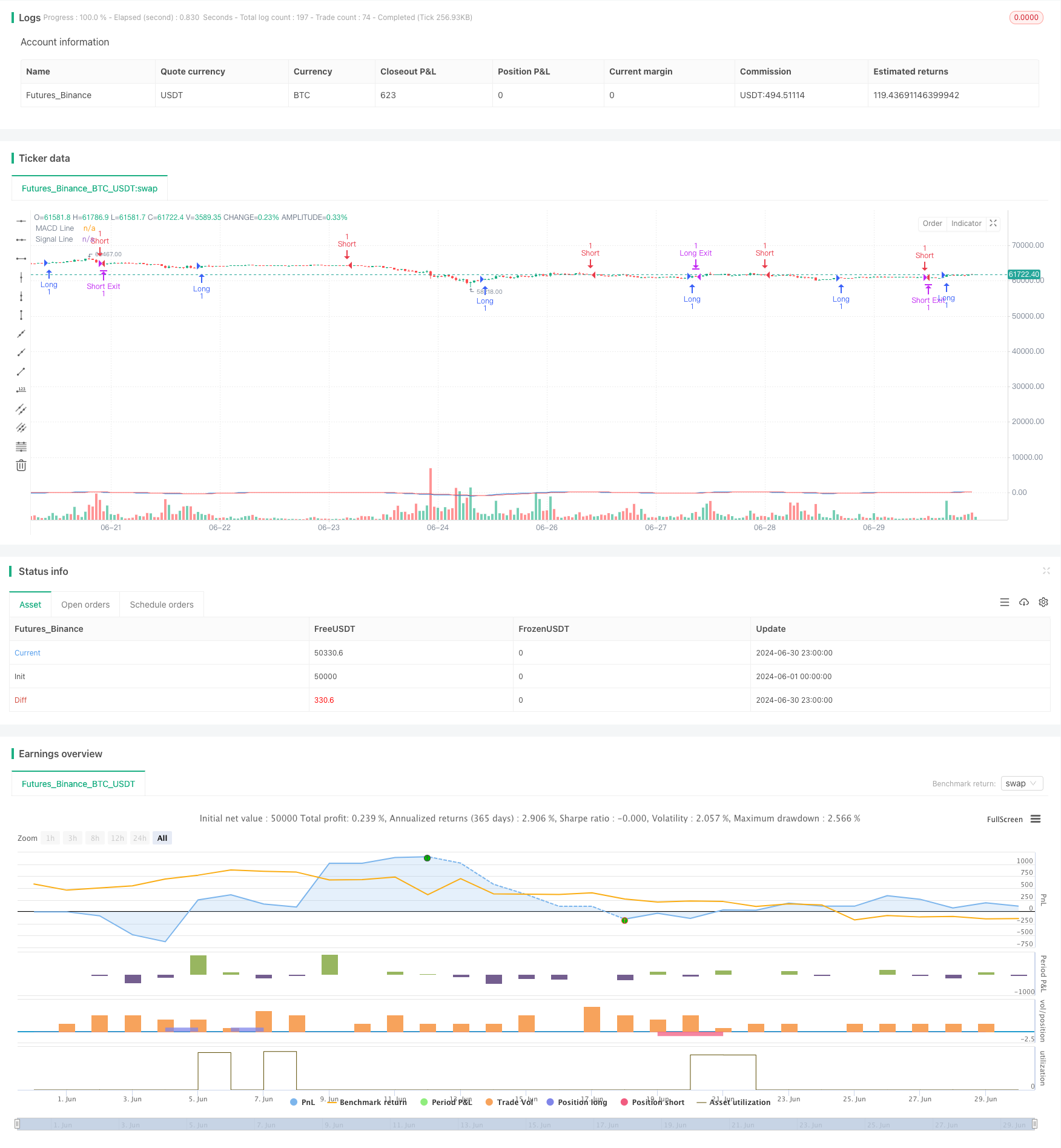MACD交叉动量策略与动态止盈止损优化
Author: ChaoZhang, Date: 2024-07-29 13:35:02Tags: MACDEMATPSLATR

概述
MACD交叉动量策略与动态止盈止损优化是一种结合了移动平均线收敛散度(MACD)指标和灵活的风险管理机制的量化交易策略。该策略利用MACD指标的交叉信号来识别潜在的趋势变化,并通过设置动态的止盈和止损点来优化交易的风险收益比。这种方法旨在捕捉市场动量,同时为每笔交易提供明确的退出策略。
策略原理
该策略的核心原理基于MACD指标的信号线交叉:
MACD计算:
- 使用12周期快速指数移动平均线(EMA)和26周期慢速EMA
- MACD线 = 快速EMA - 慢速EMA
- 信号线 = MACD线的9周期EMA
入场信号:
- 多头入场: MACD线上穿信号线
- 空头入场: MACD线下穿信号线
出场策略:
- 设置固定点数的止盈和止损
- 多头交易: 止盈 = 入场价 + 100点; 止损 = 入场价 - 50点
- 空头交易: 止盈 = 入场价 - 100点; 止损 = 入场价 + 50点
策略使用ta.macd()函数计算MACD指标,ta.crossover()和ta.crossunder()函数检测交叉信号。交易执行通过strategy.entry()和strategy.exit()函数完成。
策略优势
趋势跟踪: MACD指标有助于识别和跟踪市场趋势,提高捕捉大趋势的概率。
动量捕捉: 通过MACD交叉信号,策略能够及时进入新兴的市场动量。
风险管理: 预设的止盈止损点为每笔交易提供清晰的风险控制。
灵活性: 策略参数可以根据不同市场和时间框架进行调整。
自动化: 策略可以在交易平台上自动执行,减少人为情绪干扰。
客观性: 基于技术指标的信号eliminates主观判断,提高交易一致性。
策略风险
假突破: 在横盘市场中,MACD可能产生频繁的假突破信号,导致过度交易。
滞后性: MACD作为滞后指标,可能在快速反转行情中反应不及时。
固定止损: 使用固定点数作为止损可能不适合所有市场条件,特别是在波动性变化时。
参数敏感性: 策略性能高度依赖于所选择的EMA和信号线参数。
市场适应性: 策略可能在某些市场环境下表现良好,但在其他情况下效果不佳。
过度优化: 在回测过程中可能出现过度拟合历史数据的风险。
策略优化方向
动态止损: 使用ATR(平均真实波幅)指标调整止损点,以适应当前市场波动性。
多时间框架分析: 结合更长期的趋势判断,提高入场信号的可靠性。
过滤器: 添加额外的技术指标或价格行为模式作为过滤器,减少假信号。
仓位管理: 实现动态仓位sizing,根据市场波动性和账户风险调整交易规模。
市场状态识别: 开发算法识别趋势/震荡市场,在不同市场状态下调整策略参数。
机器学习优化: 使用机器学习算法动态优化MACD参数,提高策略适应性。
总结
MACD交叉动量策略与动态止盈止损优化是一种结合技术分析和风险管理的量化交易方法。通过利用MACD指标的趋势跟踪和动量捕捉能力,同时实施明确的止盈止损规则,该策略旨在在控制风险的同时捕捉市场机会。然而,像所有交易策略一样,它并非完美无缺。交易者需要注意假突破、滞后性和市场适应性等潜在风险。通过引入动态止损、多时间框架分析和市场状态识别等优化措施,策略的稳健性和适应性有望得到进一步提升。总的来说,这是一个值得深入研究和持续优化的策略框架,为量化交易者提供了一个良好的起点。
/*backtest
start: 2024-06-01 00:00:00
end: 2024-06-30 23:59:59
period: 1h
basePeriod: 15m
exchanges: [{"eid":"Futures_Binance","currency":"BTC_USDT"}]
*/
//@version=5
strategy("MACD Strategy", overlay=true)
// Input parameters
fast_length = input.int(12, title="Fast EMA Length")
slow_length = input.int(26, title="Slow EMA Length")
signal_length = input.int(9, title="Signal Line Length")
target_points = input.int(100, title="Target Points")
stop_loss_points = input.int(50, title="Stop Loss Points")
// Calculate MACD
[macd_line, signal_line, _] = ta.macd(close, fast_length, slow_length, signal_length)
// Strategy logic
long_condition = ta.crossover(macd_line, signal_line)
short_condition = ta.crossunder(macd_line, signal_line)
// Plot MACD
plot(macd_line, color=color.blue, title="MACD Line")
plot(signal_line, color=color.red, title="Signal Line")
// Strategy entry and exit
if long_condition
strategy.entry("Long", strategy.long)
if short_condition
strategy.entry("Short", strategy.short)
// Calculate target and stop loss levels
long_target = strategy.position_avg_price + target_points
long_stop_loss = strategy.position_avg_price - stop_loss_points
short_target = strategy.position_avg_price - target_points
short_stop_loss = strategy.position_avg_price + stop_loss_points
// Strategy exit
strategy.exit("Long Exit", "Long", limit=long_target, stop=long_stop_loss)
strategy.exit("Short Exit", "Short", limit=short_target, stop=short_stop_loss)
- 多重时间框架趋势跟踪交易系统(MTF-ATR-MACD)
- 均值回归增强型MACD-ATR策略
- 多维度黄金周五异常策略分析系统
- 交易量动态调整DCA策略
- 多层级多周期指数均线交叉动态盈利优化策略
- 动态趋势追踪与精准止盈止损策略
- Supertrend与EMA结合的动态趋势跟踪策略
- 回弹趋势双均线交易系统结合ATR动态止损优化策略
- 动态风险管理的指数均线交叉策略
- 多重指标交叉动态策略系统:基于EMA、RVI和交易信号的量化交易模型
- Darvas 盒子突破与风险管理策略
- 多时间框架融合型指数均线交叉策略
- SMA交叉多空策略结合峰值回撤控制与自动终止
- 高频翻转百分比追踪动量策略
- SMI与枢轴点结合的动量交叉策略
- 支撑阻力策略结合动态风险管理系统
- RSI-布林通道整合策略:动态自适应的多指标交易系统
- 多时框趋势跟踪与订单区块结合的量化交易策略
- 技术支撑阻力指示器精准交易策略
- 多均线交叉趋势跟踪与波动率过滤策略
- 大红蜡烛突破买入策略
- 自适应多均线交叉动态交易策略
- 基于RSI的低价动态入场与止损策略
- 云层动量交叉策略结合均线与成交量确认
- ATR-RSI增强型趋势追踪交易系统
- 多重技术指标趋势跟踪策略: 结合超级趋势、EMA和风险管理
- 多重EMA交叉趋势跟踪策略
- 改进型多指标动量交易策略
- 布林带与相对强弱指数交叉交易策略
- 确认型均线交叉动量策略